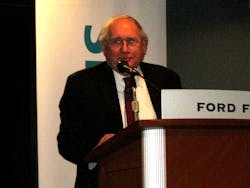Holding its second annual event last week, the Manufacturing in America Symposium, hosted by Siemens and Electro-Matic Products, continued its focus on helping manufacturers take advantage of the manufacturing upswing in the U.S. The conference was again held in Detroit, so the automotive industry was clearly a major topic of discussion. However, many of the issues discussed apply to manufacturers across industries.
Helmuth Ludwig, CEO of Siemens Industry Sector USA, pointed to two major shifts manufacturers need to be aware of to take full advantage of the industry’s resurgence in the U.S. Those shifts deal with software/mechatronics and training.
“It’s not the screwdriver on the plant floor” that drives manufacturing today, Ludwig said. “It’s the iPad.” Software is what enables manufacturing today and that means that manufacturing workers have to understand the concept of mechatronics, which encompasses mechanical, electrical and software technologies.
Knowledge of mechatronics is key to supporting mass customization capabilities, which are increasingly at the root of successful advanced manufacturing operations, Ludwig added.
But it’s not just the right software and automation products that are driving manufacturing in the U.S., he said, “It's the people.”
Given that the skills gap is the biggest issue often brought up when discussing manufacturing workers today, Ludwig did not shy away from addressing this point. However, he offered a different outlook on this issue. “It’s not a skills gap,” he said, adding that use of such terminology is “the wrong approach. Having a skills gap means the individual is responsible. But young people are not responsible for this; we are. It's a training gap.”
Ludwig added that Siemens is working with several universities and technical schools around country to address this. In particular he cited Siemens’ work participating in the development of Automation Alley’s PLM center at Oakland University in Rochester, MI, where mid-sized and smaller businesses can test and deliver products digitally.
During his address at the event, Carl Levin, U.S. Senator from Michigan, pointed to a key change that has taken place in Washington over the past few years that is helping support U.S. manufacturing. That change, he says, occurred when the federal government decided to again start make choices with industrial policy. “That term—industrial policy—is no longer viewed as the kiss of death,” Levin said. “Government has to be partner with industry just as other governments are. We will be at a competitive disadvantage if we do not, because U.S. companies are not competing with companies overseas, they're competing with countries.”
A key aspect of not having an active industrial policy for a lengthy period of time, as has been in the case in the U.S., is a lack of adequate R&D funding. Levin cited South Korea’s investment of 4 percent of GDP into R&D as an example of their commitment to industry, whereas the U.S. commits less than 3 percent of GDP toward R&D. “Plus, we have no permanent R&D deduction in our tax code. We renew these deductions every year, but that [renewal process] creates uncertainty with companies,” he said.
About the Author
David Greenfield, editor in chief
Editor in Chief

Leaders relevant to this article:
